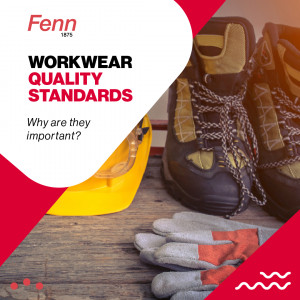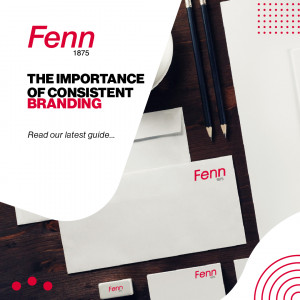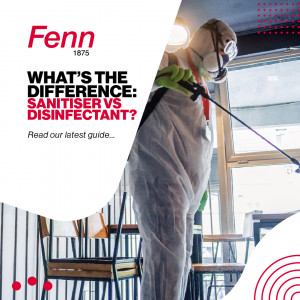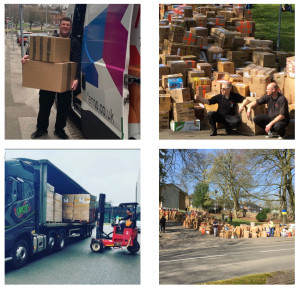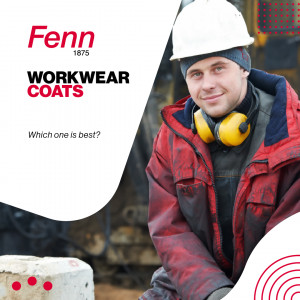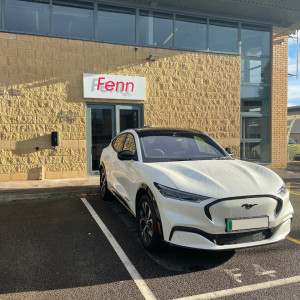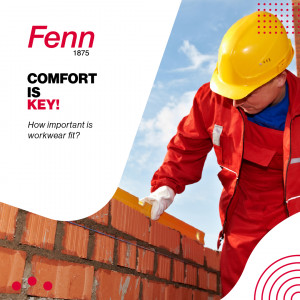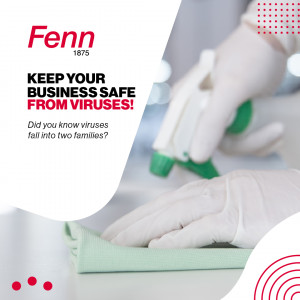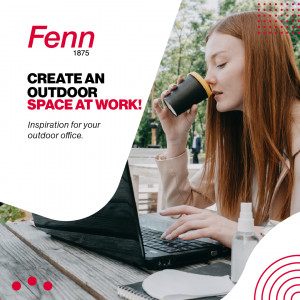Kerry
Ensuring your team has the right uniform can be difficult when certifications and quality standards come into play. Not only are you concerned about comfort, warmth, durability and in some cases branding - international health and safety standards can further complicate workwear procurement!
We’ve put together a list of the main workwear quality standards and what they mean so you can purchase your workwear with ease…
EN ISO 20471 - High visibility clothing
This comes in three different classes, showcasing how adequately the garment offers protection. Three is the highest classification, offering the most protection. For the garment to meet the ISO 20471 standard, all reflective parts must reach at least class two with the ability to reflect light. Clothing with this standard must be tested after washing to ensure the materials are durable.
EN 17353 - Workwear with enhanced visibility
This clothing class is not as strictly monitored as the ISO 20471 which is designed to be worn in more high risk areas. However it is still important to note that EN 17353 clothing is designed to be worn in medium to high risk environments and is essential for the visibility of employees.
EN 342 - Protection against cold temperatures
Working in cold temperatures isn’t pleasant and can cause serious health problems if adequate protection isn’t worn. Choosing garments at the standard of EN 342 will ensure protection - but the overall uniform is important too! Considerations around insulation, waterproofing, permeability and any accessories like gloves, boots and hats to stop losing heat.
EN 343 - Breathable, wind and waterproof clothing
This clothing class is versatile and designed to keep you safe and warm whatever the weather. Some jobs need to be carried out in snow, torrential rain or heavy winds - so ample protection needs to come from the workwear your team is wearing. Again there’s three classifications for protection and three is the highest. This is shown in the two values next to the visual - the first indicates waterproofing and the second indicates breathability.
EN ISO 11611 - Protection when welding
This standard specifies the minimum requirements for protective clothing needed for welding or performing similar tasks with comparable risks. This time there’s only two classes, one and two, with class two being the highest.
EN ISO 11612 - Protection for clothing against heat and flame
This certification is for the flexible materials used to make coveralls to protect the body, not hands and face, from heat or flames. With the exception of hats and gaiters, garments for the protection of the head, hands or feet are not covered under this criteria.
EN ISO 14116 - Protection for materials against heat and flame
This certification specifies the performance requirements for materials, material combinations and items of protective clothing with limited flame spread properties. These are designed in order to reduce the likelihood of the clothing catching fire and limiting the risk of a hazard.
IEC 61482-2 - Live working
This symbolises clothing that will protect against the thermal hazards of an electric arc. The certification involves two test methods.
The first test method: open electric arc tests the fabric and garment in order to determine the ATPV/EBT value of the clothing.
The second method: a box test determines the electric arc protection class of the fabric and the garment through the use of a forced and controlled electric arc. There are two different classes, with class two being the highest and offering the best protection.
EN 1149-3 & EN 1149-5 - Protective clothing with electrostatic properties
These certifications are for protective clothing with electrostatic properties.
EN 1149-3 - electrical discharge
This standard is for the breakdown of electrostatic charges from the surface of the clothing materials.
EN 1149-5 - materials performance and design
This certification ensures the requirements for the materials and design of electrostatic dissipative protective clothing. These garments are then used as part of a grounded system to prevent incendiary discharges.
EN 13034 (Type 6) - Protective clothing against liquid chemicals
This certification is for PPE clothing that will provide limited protection while working with and around liquid chemicals. As these garments only offer limited protection, they’re best to be used in places where contact with chemicals is limited to low volume splashes and sprays.
EN 13758-2 UPF 40+ - Protection against UV rays
Products sold with this certification provide protection against the sun’s rays - both UVA and UVB. The products are labelled with an Ultraviolet Protection Factor (UPF value), which corresponds to the protection capability.
For example, a UPF 20+ factor indicates that a maximum of 1/20 of the sun's harmful rays penetrate the clothing. This means you can expose the protected skin to the sun's rays 20 times longer than you would without protection. The highest UPF label that the clothing can carry is UPF 40+, which corresponds to a maximum penetration of 2.5% of the sun's harmful rays.
It’s important to note that the protection capability is reduced if the product becomes worn, if the care instructions are not followed or if the clothing becomes wet.
For more information on workwear classifications, email us at This email address is being protected from spambots. You need JavaScript enabled to view it.
Why consistent branding is important
When you hear the term branding - we often think of the tangibles like logos, colours and straplines. While these are all important parts of building your brand, there is a lot more to a brand than its appearance. Instead focusing more on the perception of your brand, its values and the emotions you want to invoke in your target audience will stand you in better stead.
Appearance and visual identity can change but the fundamental essence of your brand, its values and purpose, should not shift. So therefore the experience your brand creates should be consistent with the promise your messaging creates - and also consistent each time a person engages with your brand.
How do I achieve brand consistency?
Firstly, knowing and communicating your brand values and purpose to your internal team is a great place to start. Once they are onboard with the organisation’s goals and standards, you can then start to communicate this with your target audience. A set of clear brand guidelines will help anyone creating marketing materials for your brand - ensuring they stay on message and within the visual identity of the brand.
What if I’m having a rebrand?
The visual identity of your brand can change over the years. Having a brand refresh or changing the look of your brand isn’t a small undertaking - but realistically it’s important to stay with the times and can be a great way to signify shifts in brand strategy or new goals. Being strategic in your approach to the rebrand is crucial. Communicating to your internal team, current customers and target audience is important to the success of your brand’s continuation. Clear and simple messaging is the best way forward and as long as the new branded elements reflect the essence of your brand then it is likely to go down well.
What are the benefits of having a consistent brand?
Like with anything worth having, it usually takes consistent effort to achieve - and a strong brand is no different. Here’s some of the benefits you can reap after consistent brand effort…
- An easily recognizable brand
- Your audience trusts your brand more
- Your audience feels connected to and more engaged in your brand
- You can shape customer perception
How can Fenns help?
We work with you to align your brand and business goals, and then create a marketing strategy to help you grow your brand and increase your revenue.
Contact us today to grow your brand - This email address is being protected from spambots. You need JavaScript enabled to view it.
With so much jargon and conflicting advice, it’s difficult to know the best way to keep your workspace clean. Having an understanding of the buzzwords and knowing the difference between terms that are used interchangeably is important. Especially when it comes to meeting safety requirements and knowing what products you need to use.
Simple misunderstandings between commonly used terms can be the difference between using the right product for your goal and environment. So here’s what you need to know…
Sanitisation
This is defined as “reducing or eliminating pathogenic agents on the surface of something”. In the case of cleaning products, sanitisers are designed to reduce bacteria on a surface by at least 99.9% within 30 seconds.
Disinfectant
Defined as “cleaning something, usually with chemicals, to destroy bacteria”. With regard to cleaning products this means disinfectants are designed to kill a wider range of microorganisms than sanitisers.
Effectively, disinfectant is a step up above the sanitisation process and is much more powerful.
When should I sanitise?
Sanitisation is necessary in high use environments and shared spaces - especially like the office if employees eat at their desk. It helps to reduce germs and bacteria but products should not make antiviral claims as they do not kill.
When should I disinfect?
Disinfection is more for frequently touched surfaces that can be a breeding ground for germs, bacteria and viruses. Think of this like the canteen area or toilets as disinfectant aims to kill the microscopic organisms which could affect your health.
Can I just disinfect everything?
Simple answer is no - ideally you should use this method:
First clean - reduce all surface area dirt so that you have an easier time removing germs.
Next sanitise or disinfect as required. It’s also important to note that even spaces that only require a surface clean will still need to be disinfected periodically to maintain a healthy workspace.
99.9% - that’s enough to be safe?
Actually, 99.9% isn’t what it’s cracked up to be! While it’s enough for some tasks, bacteria spreads at a much more rapid rate so leaving that 0.1% may still be enough to wreak havoc on your hygiene efforts… This is where log kill reduction comes into play!
As the amount of bacteria in a space can be very large, scientists have created a mathematical function called the logarithm to help with explaining bacteria reduction. When we are using disinfectants, the purpose is to kill microbes such as bacteria and viruses on surfaces. So for a product to be deemed suitable, we need to measure the level of kill.
So then, while 99.9% kill rate sounds successful, if your starting number is 1,000,000 bacteria, you’d still be left with 1000 bacterias after disinfecting. If you use 99.999% kill rate disinfectant, that’s leaving only 10 bacterias.
It’s therefore essential to note that most official disinfectant tests require a 4 or 5 log reduction in numbers to pass the test. A 5 log (99.999%) reduction is considered the gold star in terms of reducing the possibility of human disease transmission as far as possible.
For help with keeping your workspace clean and safe, contact us at This email address is being protected from spambots. You need JavaScript enabled to view it.
Thank you for supporting the Ukraine Appeal
Thank you to everyone who has helped us in our efforts to send much needed aid and support to the Ukrainian Refugees in Poland. Our Communications Manager, Kerry Parry, coordinated the appeal by teaming up with Changing Lives Together to offer our support.
We’re pleased to share that we have delivered two loads of supplies - one in conjunction with Orbit International and UK Container Maintenance LTD. The other was full of donations from our team and wider network - a special thank you to Longton Light Alloys for a generous donation.
Our Head of Sustainability, Stephen Wiles, was able to provide much needed space and lots of church volunteers to the efforts! They worked with Changing Lives Together to repack donations – they then got an army together (including Fenns volunteers) to move almost 3000 boxes into transport.
Kerry Parry would like to share her thoughts on the cause:
"The situation in the Ukraine really hit home with the team at Fenn’s and we were keen to offer support. With the help of our suppliers, customers and local businesses pulling together, we are proud of what we’ve achieved and hope it goes some way to make a small difference to the refugees in Poland and surrounding border countries."
Thank you again to everyone who has helped with the fundraising efforts. We’re proud to be a part of such a supportive network that wants to do good in the world.
Workwear coats: which one is best?
One of the items of workwear that we get a lot of questions around is coats. Knowing which ones to select for your uniform kit isn’t always as simple as which one looks best or which is the most budget friendly.
Different roles have different needs and will require a range of waterproofing levels. If you’re stationed outside all day in torrential rain, then you’ll need much more protection than someone who works in a role where they’re called back inside as soon as a downpour starts.
So if you’re in the market for a new coat for your uniform kit then here’s what you should consider…
What conditions do your team work in?
Rescuing a stranded driver during a snow drift requires a different type of protection to a person who works at height in windy conditions. Also, knowing how long they will be exposed to the elements will dictate the non-negotiables in your coat. Consider the external situations, health and safety essentials and comfort before looking at elements like branding, fashion trends and non-essential nice to haves.
Working in snow
Having a thick insulation to keep your team warm as well as ensuring the external layer is waterproof to keep them dry. For extra comfort, having a fleece lining is great and you can find coats with fleeces that are detachable so can be used for different purposes. Mobility and visibility is also important so choosing fabrics that are reflective but breathable and people can still complete the tasks of their role is important.
Working in rain
When working in the rain, waterproofing is essential. You may not want as much insulation as a full on winter coat so a waterproof shell may be a better option with room to layer up underneath as necessary. Check particularly around the zips and seams when you are looking for full waterproofing as these areas can be make or break in terms of keeping you dry. Material breathability is also important as you want to be comfortable but not overheat.
Working in windy conditions
Windbreakers are essential for working at heights and out in the elements. Not only can the wind cause a chill, but even the slightest of breeze can throw you off balance. Having extra accessories like long cuffs and higher collars to provide protection is essential to keeping chills away. Additional thought into material could help as breathability is important as well as keeping cool or having the option of a detachable insulated layer inside.
Branded elements
The material you use will dictate the style of branding and individualisation of each of the pieces. For some materials, having sewn on logos won’t be possible as they could damage the waterproofing exterior. Also, for coats which require high visibility, you may be restricted to certain colours for reflectivity.
For help with sourcing the best workwear coats for your needs, contact us at This email address is being protected from spambots. You need JavaScript enabled to view it.
Introducing Fenn's marketing services
Want to grow your brand and get more sales? We can be your partner for unique solutions to your marketing challenges. Whether you have a marketing team in place already or you rely solely on outsourced support, our services are designed to make the process simpler for you.
Instead of having multiple service providers, we can consolidate your marketing supply chain and manage all activity to ensure return on investment and keep everything on brand. With our vast experience of managing branding projects for our customers across workwear, print and exhibitions and events, we’re now offering a formalised service.
From content and PR to marketing strategy - we will partner with you to create solutions that are unique to your specific needs.
Louise Harris, our Managing Director, states;
“Fenn’s marketing services come as a natural evolution to the expertise and assistance we already provide to our customers. It’s an exciting addition to our services and it will be great to partner more closely with our customers to offer even more value and support to their businesses.”
For help with your marketing please contact us at This email address is being protected from spambots. You need JavaScript enabled to view it.
Fenn1875 moves to new sustainable offices
Fenn1875 moves to new offices in Trentham to further its sustainability credentials on the journey to becoming carbon neutral. With the goal of being carbon net zero by 2027, the new office in Trentham Lakes is an integral part of creating a greener future and paving the way for sustainable growth.
Mapping out the future for the business, Fenn1875 worked with energy saving consultants to choose the most sustainable options for the business. Decisions were made such as choosing lighting and central heating systems with co2 reduction in mind - as a result of implementing the new systems there is a saving 37.8% on total co2 emissions. In addition the company is maximising green energy with solar panels and only using electricity that comes from certified sustainable energy sources.
Sustainability runs through the new office with carefully sourced furniture, made from environmentally friendly materials and supplied from an environmentally conscious supply chain. With space to house a new electric vehicle fleet and have an EV charging point, the offices take into consideration the roadmap to reach carbon net zero by 2027.
Louise Harris, Managing Director, states, “Planning for the future with sustainability in mind has been high on our agenda for some time. It’s great to be hitting milestones on our carbon journey earlier than expected and the new office has facilitated this. Fenn1875 is looking forward to the future and it is an exciting time for the business with continued growth and new service offerings to better serve our customers.”
How important is workwear fit?
Workwear and PPE is non-negotiable in some roles - with certain industries requiring employees to wear PPE and safety gear by law. With some industries being more strict than others with their uniform requirements, knowing the role and tasks that your employees complete will help you to choose the best workwear for them.
One often overlooked aspect when choosing workwear is the fit. However, getting it right is essential to the comfort and effectiveness of any uniform. To help you make the best choice for your workforce, here are the key things you need to consider.
Materials and durability
Having durable and breathable workwear is important as it will ensure the workwear lasts long, is fit for purpose. This sounds simple but in practice, finding uniforms with materials and fits that suit the individual, the role, safety requirements and the brand can be time consuming and frustrating. Having a trial with your team or seeing samples of the clothes can be a great way to choose your uniform before investing in a completely new set.
Individual requirements
Individual fit and comfort is a high priority because if an employee is not comfortable in the uniform, they may adapt how they wear it and as a result lose some of the safety elements. Choosing suppliers with customisation or trousers with different lengths for the leg, waist measurements done in inches instead of standard sizes can be useful. Also investing in a range of accessories such as belts or high quality socks can ensure trousers and safety shoes are worn correctly while remaining comfortable for your team.
Job requirements
A veterinary nurse will have different job requirements to a construction worker… using such a blatant example, it seems obvious. However, looking at the industry as a whole instead of individual job roles within each team could be problematic when choosing uniforms. Take the catering industry, chefs are often taught the importance of safety footwear that protects the whole foot because of the hazards in the kitchen. However, service staff who also have to go into the kitchen are not always given the same regulations regarding shoes.
Legal requirements
Working with specific tools or around hazardous chemicals will require your team to wear PPE that is designed to protect them from the specific risk. However, providing your team with incorrect sizes in gloves - even if they’re of the legal specification - is ineffective. Having a range of sizes available for your team will reduce risks further and ensure the items fit well and leave no skin uncovered.
Corporate branding
Wanting your team to look onbrand should not come at the expense of clothes that are a good personal fit. One way of doing this is to choose your uniform items then work with yiiur supplier to have them branded or personalised in the way that works best for the item’s material. Choosing a colour that fits in with your brand palette will strengthen your look too.
Partnering with a supplier that can cater to a range of uniform requirements, personal sizes and help with choosing items that are on brand but also comfortable will make your workwear process much easier.
Email us at This email address is being protected from spambots. You need JavaScript enabled to view it. today to discuss your workwear requirements.
Keep your business safe from viruses
You’ve probably seen the constant mention of Monkeypox in the news along with Covid. Well, there is now a rise in Poliovirus too. With a seemingly never ending stream of new viruses emerging, focus on cleanliness and public health is high. However most of us aren’t aware that there are two types of virus - enveloped and non-enveloped - so you’ll need to bear this in mind when you are buying products to keep your workplace clean and sanitised.
What’s the difference between enveloped and non-enveloped viruses?
Basically it comes down to a virus’ structure and composition. The Virology Research Services site explains:
In general, what distinguishes them is the presence (for enveloped viruses) or absence (for non-enveloped viruses) of a lipid bilayer membrane on the outer part of the virus… Viruses are composed of two main components: the viral genome (which can be RNA or DNA) and the virus-coded protein capsid that surrounds the genome. If the virus particle contains only these two elements, it is called a non-enveloped virus. If the virus particle contains an extra lipid bilayer membrane surrounding the protein capsid, it’s called an enveloped virus.
So when products are made to tackle viruses, they need to be tested against both variants to ensure they work effectively and as stated.
Why is this important?
After the pandemic, public interest and media coverage of viruses has increased. Monkeypox (an enveloped virus) is the latest to hit national headlines and Poliovirus, the virus that causes Polio (a non-enveloped virus) has also re-emerged in the UK.. Health organisations are encouraging extra protection around personal health and public sanitization. This can be seen with recent campaigns around vaccines, face coverings and social distancing, with this still going on for groups of people who are thought to be more at risk in terms of infection or with health vulnerabilities.
What is the challenge for businesses?
With pressure to maintain clean environments for staff, as well as the wider pressures of running a business during uncertain economic times, people want to know how to protect employees and customers in the most time efficient and cost effective way. The necessity to use a wide ranging portfolio of Infection Prevention products is still valid, despite the other struggles. There has never been a greater time for the cleaning industry to demonstrate continued vigilance and high levels of biosecurity and hygiene within their cleaning regimes.
How can Fenns help?
Fenns has a robust Infection Prevention range of products engineered to protect the working environment. The virus that causes Monkeypox has been added to the ULTRA AX efficacy claims – this is effective in 60 seconds.
For those customers using concentrates and chemical dosing, ULTRA XTREME as well as being efficacious for enveloped and non-enveloped viruses, is also certified to inactivate the Poliovirus.
We stock disinfectants that will tackle both enveloped and non-enveloped viruses, including COVID and variants, Monkeypox and Poliovirus.
Email This email address is being protected from spambots. You need JavaScript enabled to view it. if you would like our help with your janitorial processes.
Create an outdoor space at work
With the heatwave in full swing, social media is awash with pictures of people working outside during their work from home days. If you’re based in the office - it’s easy to feel like you’re missing out on the already too brief summer. Some simple switches and creative thinking could transform any available outdoor space you have access to at work.
The pandemic brought with it a trend of outdoor socializing that allowed us to catch up with the rest of Europe. As a consequence, outdoor furniture available to the UK has evolved to give us more freedom in all facets of our life. With even a small space, you can create an outdoor area that suits your team’s needs. Here’s some ideas:
Informal meeting space
Working outdoors is thought to improve stress levels so no wonder it’s a great way to tackle those difficult conversations. Informal meetings are one of the most simple ways to get outside with your team. On really hot days, you might want to give the walking meetings a miss and have somewhere to sit instead.
You can easily create a multifunctional space with a small terrace table and chairs, with a shaded area to protect you from the sun. In winter, outdoor heaters can transform the space to make the cold bearable and a canvassed area can protect you from the light rain.
Board meetings and group sessions
Making use of a larger table and weatherproof chairs can mean more time outside for bigger meetings and group sessions. For creative team meetings, these can be a great source of inspiration as it takes you out of the office and into a different environment, where ideas can flow.
Without the confines of the office or a traditional meeting space, barriers drop and people are much more likely to share openly. This enhances productive discussion as the outdoor space is said to promote feelings of trust, community and goodwill.
Relaxing spaces
With reports that being outside can boost your mood by 20%, giving your team a space to unwind can help relieve the tension of workday stresses. Humans don’t thrive when they have to sit down in front of a screen for 8 or more hours a day. Giving them a space to go to where they can relax during breaks or quiet periods will improve happiness.
Incorporating greenery into your outdoor space will also improve focus restoration by up to 8%. Allowing your team to get outside after finishing a complicated task will help them to recover quicker and focus on what they have to do next.
Solo working
Working outside boosts energy levels - with 20 minutes of being in the open air said to have as much of a boost as a cup of coffee. Having a few tables and chairs or outdoor benches can provide a quiet working environment that’s away from the business of the office. In addition, a 20% short term memory increase can happen when working in nature. With extra energy, focus and memory - tasks can be completed faster and engagement levels are higher.
For inspiration on how to create an outdoor working environment, email us at This email address is being protected from spambots. You need JavaScript enabled to view it.
